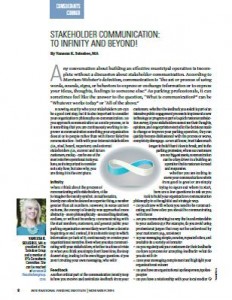Any conversation about building an effective municipal operation is incomplete without a discussion about stakeholder communication. According to Merriam-Webster’s definition, communication is “the act or process of using words, sounds, signs, or behaviors to express or exchange information or to express your ideas, thoughts, feelings to someone else.” As parking professionals, it can sometimes feel like the answer to the question, “What is communication?” can be “Whatever works today” or “All of the above.”
Knowing exactly who your stakeholders are can be a good first step, but it is also important to consider your organization’s philosophy on communication. Do you approach communication as a finite process, or is it something that you are continuously working to improve? Is communication something your organization does at or to people rather than with them? Effective communication—both with your internal stakeholders (i.e., staff, board, superiors) and external stakeholders (i.e., current and future customers, media)—can be one of the most effective operational tools you have, so it’s important to consider not only how, but also why, you are doing it in the first place.
Infinity
When I think about the process of communicating with stakeholders, I like to imagine the infinity symbol. In mathematics, infinity can often be defined as a specific thing, a number greater than all numbers. However, in some ancient cultures, the concept of infinity was approached more abstractly—more philosophically—as something limitless, endless, or without boundary. Communicating with the staff members, customers, and general public your parking organization serves likely won’t have a definite beginning or end. Instead, it is an infinite loop in which information (or lack of it) continuously re-creates your organizational narrative. Even when you stop communicating with your stakeholders, whether in a time of crisis or when you think you simply don’t have time, the loop doesn’t stop, leading to the even bigger question: If you aren’t creating your own messaging, who will?
Feedback
Another critical part of the communication infinity loop is how you receive and assimilate feedback from your customers. Whether the feedback you solicit is part of an intensive public engagement process to implement a new technology or program or part of a quick customer satisfaction survey, if your stakeholders cannot see their thoughts, opinions, and fingerprints reflected in the decisions made to change or improve your parking operation, they can quickly become disillusioned with the process or worse, completely disengage. As we all know, trust takes much longer to build than it does to break, and in the parking profession, where our customers are our biggest assets, communication can be a key driver in a building an operation that is customer-focused and responsive.
Whether you are looking to move your communication efforts from good to great or are simply trying to figure out where to start, here are a few questions to ask as you look to build your organization’s communication philosophy in a thoughtful and strategic way:
- Do you know with whom you need to be communicating and how often you should be communicating with them?
- Are you communicating in a way that is understandable to your audience(s)? For example, do you avoid using professional jargon that may not be understood by your customers (e.g., scofflaw)?
- Is your messaging simple, concise, repeated often, and available in a variety of formats?
- Do you regularly ask your customers for their feedback? Do have a process for accepting feedback? What do you do with it?
- Does your messaging complement and highlight your organizational values?
- Do you have an organizational spokesperson/spokespeople?
- Do you have a relationship with your local media?
Vanessa K. Solesbee, MA is president of The Solesbee Group and a member of IPI’s Consultants Committee. She can be reached at vanessa@thesolesbeegroup.com.
TPP-2014-11-Stakeholder Communication To Infinity and Beyond!

